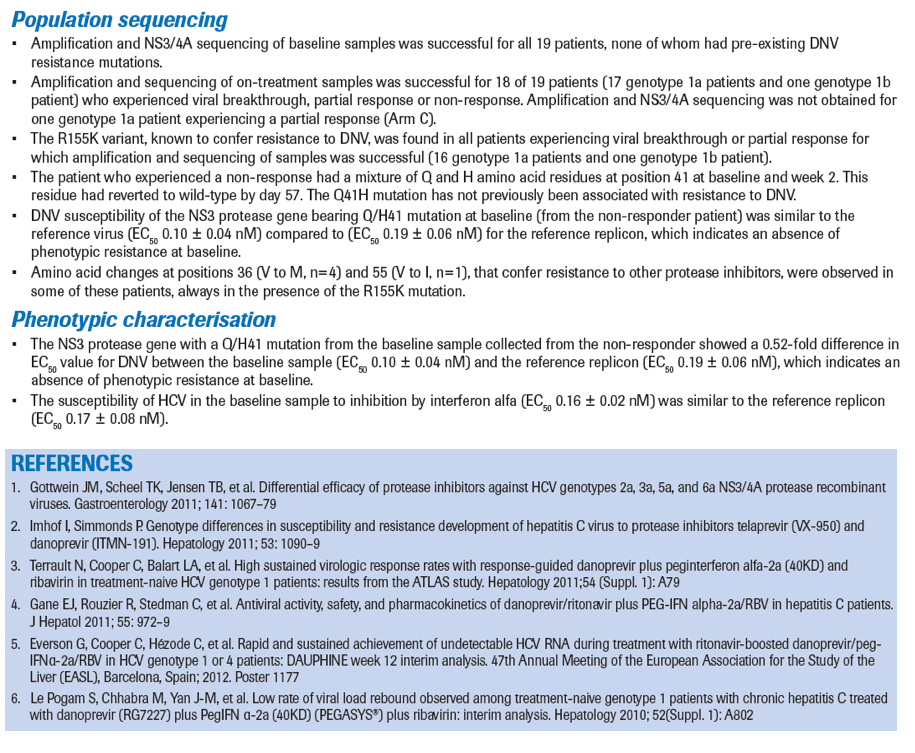 |
 |
 |
| |
Low rate of on-treatment resistance to danoprevir bosted by ritonavir (DNVr) combined with peginterferon alfa-2a (40KD)/ribavirin: 12 week interim analysis from the DAUPHINE study
|
| |
| |
Reported by Jules Levin
EASL 2012
S. Le Pogam,1 M.T. Navarro,2 L. Bu,3 A. Voulgari,4 M. Ilnicka,5 J.M. Yan,1 K. Klumpp1 and I. Najera1
1Virology Discovery, Hoffmann-La Roche, Nutley, New Jersey, USA; 2Biostatistics, Genentech, South San Francisco, CA, USA; 3Biostatistics, Roche Pharma Development in Asia Pacific, Shanghai, China; 4Clinical Development Roche Products Ltd, Welwyn, UK;
5Discovery Technologies, Hoffmann-La Roche, Nutley, New Jersey, USA
CONCLUSIONS
· In this 12-week interim analysis, a low rate of resistance to DNV was observed among HCV genotype 1 patients receiving DNVr plus P/R (4.6%).
· Resistance while on treatment with DNVr was associated with:
-- The NS3 R155K substitution
-- Occurred predominantly in the lower dose
-- Among patients with HCV genotype 1a infection.
· One patient showed a viral load profile meeting the definition for non-response. Phenotypic analysis of the baseline HCV sample from this
patient (with the Q/H41 mutation) showed susceptibility to DNV, with an EC50 value similar to the reference control. Thus, non-response was
unlikely to be due to the presence or rapid selection of DNV-resistant virus.
· These observations are consistent with the higher genetic barrier to selection of danoprevir resistance in patients infected with HCV
genotype 1b.
INTRODUCTION
· Danoprevir (DNV; RG7227) is a potent macrocyclic, second-generation hepatitis C virus (HCV) protease inhibitor that is active against HCV genotypes 1, 4 and 6.[1, 2]
· The combination of DNV plus peginterferon alfa-2a (40KD) and ribavirin (P/R) produced sustained virological response rates of up to 85% in treatment-naive HCV genotype 1-infected patients enrolled in the phase II ATLAS trial.[3]
· DNV in combination with ritonavir increases antiviral potency at substantially lower systemic exposures of DNV alone.[4]
· The efficacy and safety of ritonavir-boosted DNV (DNVr) plus P/R in treatment-naive HCV genotype 1- or 4-infected patients is currently being evaluated in the phase II DAUPHINE study.[5]
· As shown in Figure 1, patients randomised to arms A, B and C in DAUPHINE received different doses of DNVr in combination with P/R for 24 weeks, while patients randomised to arm D received a 12- or 24-week response-guided regimen of DNVr plus P/R. Patients in the control arm (E) received P/R for 48 weeks. Patients in arm E who did not achieve a virological response, but had a ≥1 log10 IU/mL decrease in HCV RNA titre at week 12, were eligible to enter a 24-week DNVr plus P/R roll-over regimen.
Figure 1. Study design showing number of patients who were randomised and received at least one dose of study medication[5]

DNVr = oral danoprevir plus ritonavir; P/R = peginterferon alfa-2a (40KD) plus ribavirin; eRVR2 = extended rapid virological response (undetectable HCV RNA, <15 IU/mL) at week 2 maintained through week 10.
Peginterferon alfa-2a (40KD) was administered subcutaneously at a dosage of 180 μg/week; Ribavirin was administered orally at a dosage of 1000 mg/day (body weight <75 kg) or 1200 mg/day (body weight
≥75 kg) in two divided doses. *Treatment followed by a treatment-free follow-up period of up to 24 weeks.
OBJECTIVE
· The objective of this study is to report the results of an interim week 12 analysis of viral resistance development from patients enrolled in the DAUPHINE study.





|
| |
|
 |
 |
|
|